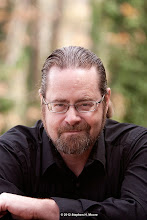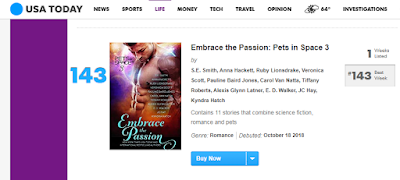When I was chiefly a reader and not interested in
selling my scribbles, I’d buy a book because it looked fun or was recommended
to me, and other than broad categories like romance or fantasy or whatever a
book store considered “general fiction,” I didn’t pay attention to its market. I
also didn’t pay a whole lot of attention to whether a book was written in
first-person, second-person, or third-person point of view. (Aside: If you have
no idea what I’m talking about when I reference “point of view” in terms of
writing craft, Jeffe Kennedy did a fab run-down earlier this week.)
Now that I am trying to sell my stories to other folks, I pay a lot more attention to point of view, and I’ve discovered a few patterns. Here are some quick answers to "which point of view do I use for my story?" quandaries.
Lots of characters with thoughts? You want to use third person.
In books where readers get the interior thoughts of more than two characters, writers tend to use the third-person point of view. Think of, for instance George R.R. Martin’s A Song of Ice and Fire fantasy series: so, so many characters, and a large number of them are point-of-view characters (i.e., we experience the story through their “eyes” and thoughts). If that epic were in first person, I would be perpetually confused.
Note that I’m careful here to recommend third-person
specifically for stories that feature the interior thoughts of more than two
characters. I did not say fantasy as a whole. Some fantasy writers manage to
tell stories using first-person and make it not at all confusing. However, the
successful fantasies that do this typically focus narrowly on one character,
sometimes two. Amanda Bouchet’s recent Kingmaker series, for instance, is
written in first person, but since we are only given and are only interested in
the main character Cat’s point of view, the first-person POV works well.
Main character in the young-adult(ish) range? First person.
YA novels, regardless of their genre, tend to be written in first person. If you read a few, you can see why this POV choice aids the purpose of a YA book. Because a good YA book is about one character’s attempt to grapple with relevance in a world that keeps telling them “you don’t matter yet,” the narrative must of course be all in that character’s head. It must of course be suffused with all the agony and frustration and hope and striving that is typical of not-quite-adult-ness. First-person point of view allows angst-wallowing in a way that no other POV choice can.
Hint: the POV recommendation is applicable to character age
and also reader age. If your target audience -- your market
– is young adult, first-person POV is a good choice.
Similarly, if your characters are recent teens and now just
barely adults – a niche that was until recently called “new adult” – I’d stick
with first-person POV. First-person books featuring 22-year-olds in their first
post-college job yet still making iffy decisions tend to sell a lot better than
third-person omniscient books covering similar topics. Somehow, if the character
does a boneheaded thing blithely , optimistically, and with no thought of
possible consequences, it feels like a grand adventure rather than a poor life
choice. Plus, if such an episode were written in third person, there’s always a
danger it might sound judgy.
Are sensory details super important to the story? First person.
I’m going to disagree with my awesome co-SFFSevener, K.A. Krantz, and say that if you’re writing erotica or erotic romance, first-person POV is the way to go. Most erotic stories are written in the first person, so it’s a reader expectation. Also, in erotica, if you’re doing it right, the sensory details are front and center. In a story that is about the character completing his or her arc by having sexual adventures, nothing matters more than how that character feels. I mean both internal thought feeling and also satin-sheets, chocolate-sauce, feather-tipped leather feeling. Do I need to go on?
Often paranormal and urban fantasy stories are written in
first person, and again, I think that sensory (or in this case, extrasensory)
details are central to those sorts of stories.
Trying to sound literary or experimenting with an unreliable narrator? Either first or second might be fun.
Most of the time, second-person POV is only useful for experimental literary fiction or choose-your-own-adventure stories. Note that the latter are not exclusively for kids. A site called Silkwords used to publish choose-your-own-adventure erotica and erotic romance stories, and they were definitely not for kids.
Do I have to pick just one?
Er… technically no? One of my favorite young adult books, The Farm by Emily McKay, uses first person for the main character and her sister and third person for Carter, whose loyalty and good intentions we are supposed to doubt at the beginning. Although using both point-of-view choices works brilliantly for this story, I’m not sure it’s a good idea for a writer with less experience and storytelling command to try. So, although no, technically you don’t have to pick just one POV, please do realize that picking two complicates your work. A lot.
What about you, Viv?
Oh right. My opinion. Seriously, this is necessary? The truth is, I’m an easy read and have favorites using all kinds of narrative choices. However, though I won’t throw a book against a wall just because it’s, say, in first-person present, most of my DNFs (books I did not finish reading) tend to be told in first-person from the point of view of a character I can’t root for. Sometimes that character is too whiny, too certain he’s funny when he’s not really, too oblivious, or too self-absorbed. Sometimes I just can’t bear to be in the head of that person for 300 pages.
Bottom line, though, think about this before you start writing, make a deliberate choice taking all market and reader and genre expectation variables into consideration, and then tell me your story. If you tell it well
enough, I won’t even stop to worry about your POV choice.











